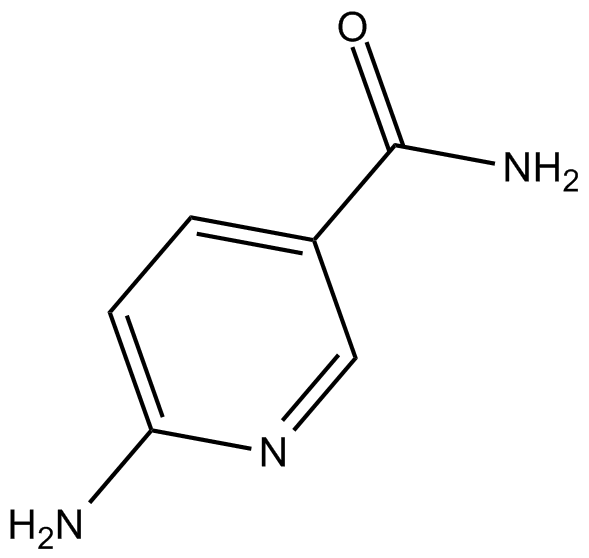6-Aminonicotinamide (Synonyms: 6-AN,NSC 21206,SR 4388) |
| Catalog No.GC10462 |
6-phosphogluconate dehydrogenase inhibitor
Products are for research use only. Not for human use. We do not sell to patients.

Cas No.: 329-89-5
Sample solution is provided at 25 µL, 10mM.
Ki: 0.46 μM
6-Aminonicotinamide is a 6-phosphogluconate dehydrogenase inhibitor.
6-Phosphogluconate dehydrogenase, an enzyme in the pentose phosphate pathway, can produce ribulose 5-phosphate from 6-phosphogluconate. 6-Phosphogluconate dehydrogenase is also an oxidative carboxylase catalyzing the decarboxylating reduction of 6-phosphogluconate into ribulose 5-phosphate in the presence of NADP.
In vitro: 6-Aminonicotinamide could be metabolized to 6-amino-NAD(P+), a competitive inhibitor of NAD(P+)-requiring processes, especially the pentose phosphate pathway enzyme, 6-phosphogluconate dehydrogenase. Moreove, 6-aminonicotinamide as a single agent could cause a significant inhibition of glycolytic flux but had no effect on the pentose phosphate pathway. 31P-NMR studies of perifused RIF-1 cells indicated that 4 h of exposure to 6-aminonicotinamide was enough to cause significant accumulation of 6-phosphogluconate, the substrate for this enzyme [1].
In vivo: The influence of 6-aminonicotinamide on the G-6-P-DH- and 6-PG-DH-levels of the pentose phosphate pathway in the kidney was investigated. Following i.p. administration of 6-aminonicotinamide at 6 mg/kg, the 6-PG-level rose from a value less than 10 nmoles/g to 1000 nmoles/g fresh weight within 24 h. In addition, at the end of the assay, after 7 days, a 6-PG-concentration of about 150 nmoles/g fresh weight was still seen. Moreove, the G-6-P level simultaneously rose with the 6-PG-level to about 150% of the control level and returned to normal on the 5th day [2].
Clinical trial: So far, no clinical study has been conducted.
References:
[1] Street, J. C.,Alfieri, A.A. and Koutcher, J.A. Quantitation of metabolic and radiobiological effects of 6-aminonicotinamide in RIF-1 tumor cells in vitro. Cancer Research 57, 3956-3962 (1997).
[2] Lange, K. and Proft, E.R. Inhibition of the 6-phosphogluconate dehydrogenase in the rat kidney by 6-aminonicotinamide. Naunyn-Schmiedeberg's Archives of Pharmacology 267, 177-180 (1970).
| Cas No. | 329-89-5 | SDF | |
| Synonyms | 6-AN,NSC 21206,SR 4388 | ||
| Chemical Name | 6-amino-3-pyridinecarboxamide | ||
| Canonical SMILES | Nc1ccc(cn1)C(=O)N | ||
| Formula | C6H7N3O | M.Wt | 137.1 |
| Solubility | ≥ 13.7mg/mL in DMSO | Storage | 4°C, protect from light |
| General tips | Please select the appropriate solvent to prepare the stock solution according to the
solubility of the product in different solvents; once the solution is prepared, please store it in
separate packages to avoid product failure caused by repeated freezing and thawing.Storage method
and period of the stock solution: When stored at -80°C, please use it within 6 months; when stored
at -20°C, please use it within 1 month. To increase solubility, heat the tube to 37°C and then oscillate in an ultrasonic bath for some time. |
||
| Shipping Condition | Evaluation sample solution: shipped with blue ice. All other sizes available: with RT, or with Blue Ice upon request. | ||
| Prepare stock solution | |||

|
1 mg | 5 mg | 10 mg |
| 1 mM | 7.2939 mL | 36.4697 mL | 72.9395 mL |
| 5 mM | 1.4588 mL | 7.2939 mL | 14.5879 mL |
| 10 mM | 0.7294 mL | 3.647 mL | 7.2939 mL |
Step 1: Enter information below (Recommended: An additional animal making an allowance for loss during the experiment)
 g
g
 μL
μL

Step 2: Enter the in vivo formulation (This is only the calculator, not formulation. Please contact us first if there is no in vivo formulation at the solubility Section.)
Calculation results:
Working concentration: mg/ml;
Method for preparing DMSO master liquid: mg drug pre-dissolved in μL DMSO ( Master liquid concentration mg/mL, Please contact us first if the concentration exceeds the DMSO solubility of the batch of drug. )
Method for preparing in vivo formulation: Take μL DMSO master liquid, next addμL PEG300, mix and clarify, next addμL Tween 80, mix and clarify, next add μL ddH2O, mix and clarify.
Method for preparing in vivo formulation: Take μL DMSO master liquid, next add μL Corn oil, mix and clarify.
Note: 1. Please make sure the liquid is clear before adding the next solvent.
2. Be sure to add the solvent(s) in order. You must ensure that the solution obtained, in the previous addition, is a clear solution before proceeding to add the next solvent. Physical methods such as vortex, ultrasound or hot water bath can be used to aid dissolving.
3. All of the above co-solvents are available for purchase on the GlpBio website.
Quality Control & SDS
- View current batch:
- Purity: >98.00%
- COA (Certificate Of Analysis)
- SDS (Safety Data Sheet)
- Datasheet
Average Rating: 5 (Based on Reviews and 39 reference(s) in Google Scholar.)
GLPBIO products are for RESEARCH USE ONLY. Please make sure your review or question is research based.
Required fields are marked with *



















